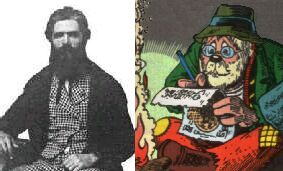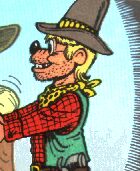"The Dutchman"
- Owner of one of the most famous lost gold mine -
( 1808 - 1891 )

- Owner of one of the most famous lost gold mine -
( 1808 - 1891 )

| * List of the stories
he appears in :
- D 96089 : "The Vigilante of Pizen Bluff" (Lo$ #6b), from 1996, by Don Rosa ; - D 98202 : "The Dutchman's Secret", from 1999, by Don Rosa. |
* His biography : (Note
that this biography is not 100% facts. A lot of versions, hypothesis and
dates have been told about the life of this mysterious character, and I
tried to mix with the more complete and coherent ones. I can't even tell
for sure that the man on photograph above is the real Jacob Waltz, just
that it was believed by a lot of people to be him.)
Although he was surnamed the
"Dutchman", Jacob Waltz was in fact born Oberschwandorf,
Wurttemberg, Germany, in 1808. His family were farmers. He first studied
mining in Germany.
Around 1940, he emigrated to Saint
Louis, Missouri, USA, and he left for the gold fields in Carolina and Alabama,
but as he didn't find work to sustain himself, he drifted westward. In
1848, he went to Natchez, Mississippi, where he asked for naturalisation
as an Amerian citizen, but his application was declined. He then went to
the California Gold Rush, where he worked as a miner for several companies
throughout the 1850's. In 1861, he applied again for naturalization in
Los Angeles, and was accepted. In 1868, he migrated to Phoenix, Arizona,
where he worked digging irrigation ditches along with several other German
immigrants, planting crops, raising chickens and hogs, and was also hired
as a laborer.
One day, at the beginning of the
1870's, along with his friend and partner Jacob Weisner (or Weiser),
he helped a Miguel Peralta, son of Gonzales
Peralta, himself son of Don Miguel Peralta,
during a fight in Mexico. In acknowledgement, Miguel told them about a
fabulous treasure : a gold mine discovered by his family in 1847, in the
Superstition Mountains, and helped them finding it. Once they found it,
they left it with a very poor amount of gold, purchased by Apaches, who
considered this territory as sacred. Peralta didn't want to go back here.
Waltz later came back here with Weisner, but Weisner was killed by Apaches
(or by Waltz himself [?]) : all the gold were Waltz's, but, probably upset
by Weisner's death, he never filed a claim for the mine. He hid the nearly
pure gold that was present. Later on, without working the mine, he retrieved
the gold from a variety of hiding places, which he had created. He made
several trips here until 1878, and came back into town. It is said that
he sold some of his gold around Florence.
One day in 1891, after a heavey
rainfall that caused flooding, destroyed his farm, trapped him during several
days and made him catch a pneumonia,Waltz discovered that Julia Thomas,
an Afro-american friend of his (he used to deliver fresh eggs to her) who
didn't know anything about the mine and took care of his delicate health,
was in debt and in danger of losing her ice-cream bakery, and he offered
to help her repay her debts with his gold. Until the moment that he showed
her gold ore worth about $1,500, Julia thought he was a poor farmer (we
wore dusty and torn clothes).
He died on October 25, 1891. A lot
of people tried to find his mine, among them, Julia Thomas herself (Waltz
promised to share the wealth of the mine with her and her adopted son,
Rhinehart Petrasch). They planned a trip into the Superstitions during
the spring of 1892 to retrieve the rest of the gold in Waltz's cache, but
nobody succeeded.
* His place in the Barks/Rosa stories universe
:
First, in "The Vigilante
of Pizen Bluff", which takes place in 1890, in Pizen Bluff, near Phoenix,
old Jacob Waltz gives Scrooge two maps of gold mines he drew behind posters
: the Peg-Leg Mine, in California, in which he says he had hidden two bags
filled with gold nuggets, and the Peralta Mine
(the actual Lost Dutchman Mine). He says he discovered it but that
he couldn't take a lot of gold because of the dangerous Apaches. He doesn't
believe in him, and throw the Peg-Leg map, but, on point to throw the Peralta
one, he discovers it is drawn under a publicity poster for a show including
his Uncle Angus and Buffalo Bill and presented
by P.T. Barnum, so he kept the map. More than
60 years later, while Scrooge is telling this adventure to his nephew,
they tell him, thanks to their Junior Woodchuck Guidebook, that Jacob Waltz,
although he's German, IS "The Dutchman", and so, that the mine exists...

Then, in "The Dutchman's Secret", a sequel for "The Vigilante of Pizen Bluff", the Ducks decide to go to Apache Junction, Arizona, with the map, to look for the gold. They eventually find the mine, and a letter drawn by Jacob, which tells his story. He is seen in panels through several periods of his life. Weisner is also seen on two panels. In this story, the Peralta who helped Waltz isn't named, while his father (Gonzales) is and his grandfater, the Peraltas' patriarch (Don Miguel) too. Jacob Weisner is just called by his last name Weisner, and Jacob Waltz nicknames himself "Jack" on his letter.

Jacob Weisner